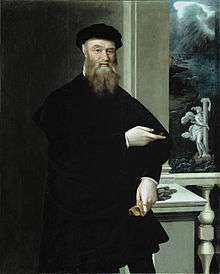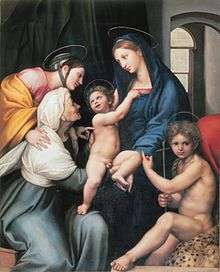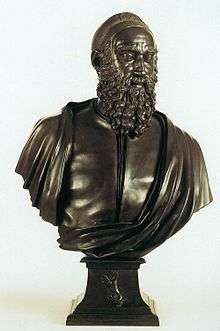House of Altoviti
The Altoviti are a prominent noble family of Florence.
| House of Altoviti | |
|---|---|
| Noble family | |
 | |
| Country | Italy France |
| Founded | 1200 |
| Founder | Altovito Corbizzi (1200 - 1250) |
| Titles | Marquis Count Patriarch of Antioch Archbishop of Athens Archbishop of Fiesole Archbishop of Florence |
| Cadet branches | Altoviti Medici Altoviti Cybo Altoviti Avila Altoviti San Galletti |
Since the Medieval they were one of the most distinguished banking and political families appointed to the highest offices of the Republic of Florence, friends and patrons of Galileo Galilei, Vasari, Raphael and Michelangelo.
Through a predominant endogamous marriage policy they established alliances with dynasties of principal and papal nobility as the Medici, Cybo, Aldobrandini, Rospigliosi, Sacchetti and Corsini.
Since the fourteenth century they had a close personal relationship with papacy. Three popes have blood relations with the Altoviti; Innocent VIII, Clement IX and Clement XII.
Pope Innocent VIII was the uncle of La Papessa Dianora Altoviti Cybo. Her son Bindo Altoviti became one of the most influential papal bankers and patron of the arts of the Renaissance.
The House of Altoviti is still present and possesses the title of marquis.
Notable members

Frequently members of the family distinguished themselves in value, defending or serving the Florentine Republic holding prestigious public, political, military and religious offices.
- Giovanna Altoviti (1305-1395), known as Madonna Aldobrandini
- Iacopo Altoviti (1348-1403), Bishop of Fiesole
- Bardo di Altoviti (1342-1405), one of the Eight Saints
- Antonio Altoviti (1454-1507), papal banker and papal Master of the Mint
- Bindo Altoviti (1491-1557), papal banker and patron of the arts of the Renaissance
- Antonio Altoviti (1521-1573), Archbishop of Florence
- Giacomo Altoviti (1604-1693), Patriarch of Antiochia and Archbishop of Athens
- Filippo Nero Altoviti (1634-1702), Bishop of Fiesole
- Antonio Altoviti Avila (1914-), actor and producer, Academy Award-winning movie Yesterday, Today and Tomorrow.
Stemma
Pope Pius II presumed the family would be of Roman origin as in Fiesole was found a tomb with a Roman inscription quoting Furio Cammillo Altovita grandson of Furio Camillo, general, statesman and one of the most famous heroes of the early Roman Republic, honored with the title of Second Founder of Rome for his victory over the Gauls during the Gallic siege of Rome.[1] According to the family legend, he silver Italian wolf on black background refers to the Roman origin of the family and is the mythical she-wolf Lupa Capitolina Romana who would have protected the founder of the dynasty Furio Camillo by devouring his enemies.

The family came to Florence in the twelfth century. They engaged in the usual mix of culture, commerce (mainly wool and salt), banking and politics. Many were respected judges and diplomates at royal and papal courts. They belonged to the pro-papal elite of the Guelph faction. With an old military tradition, not a few members of the family were considered supremely valiant captains in numerous decisive battles of the Florentine Republic. Therefore, some scholars believe the heraldic wolf was granted by Emperor Frederick II as award for brave captains.[2]
Art & Culture
Antonio Altoviti married Dianora Altoviti Cybo and was made papal Master of the Mint by her uncle Pope Innocent VIII. Like other Florentines banking families who provided loans to the popes in exchange for the rights to papal revenues, the Altoviti prospected.
Antonio Altoviti's son Bindo Altoviti was appointed as Depository General, the leading banker of the Papal States and chief commissioner for collecting taxes, mainly allocated for the reconstruction of the St. Peter's Basilica. After the death of Agostino Chigi and the sack of Rome in 1527, only a few wealthy banks had the capital to prevent economic chaos. Competing with fierce Genoese bankers and the Germans Fugger and Welser; the Strozzi, Salviati and Altoviti became the leading Florentine and curial bankers, given the chance to participate in massive credit transactions, controlling an enlarging sphere of papal finance.[3]

Bindo Altoviti gradually expanded and diversified his financial activities, established dependences of the Altoviti Bank in foreign money markets as France, Netherlands and England. Among his clients were duke Charles III of Savoy and king Henry II of France and by shrewd political and financial acumen he amassed one of the largest private fortunes in Italy
He enjoyed the financial resources to undertake extensive renovations to the properties he inherited from his father and his suburban villa on the Tiber to indulge a growing passion for art. Known and endowed with a strong taste for art, he became a patron of the arts and friend to Vasari, Cellini, Raphael and Michelangelo.[4]
Immortalized by Raphael and Cellini, he harbored Michelangelo when he fled from Florence to Rome.[5] Michelangelo had such a high esteem for him (while he despised his rival Agostino Chigi) that he gave him as a gift the cartoon of Noah's Blessing, used in the vault of the Sistine Chapel (lost) as well as a design of a Venus (lost) colored then by Vasari.[6]
In Florence on Piazza del Limbo they had a palazzo with a large family coat of arms on the facade and detained the patronage of the church Santi Apostoli. It was also Michelangelo who convinced Bindo, not to rebuild, but to preserve the church. Vasari painted the Allegory of the Immaculate Conception for the family chapel.[7]

In Rome Vasari also used to stay at the Palazzo Altoviti where he frescoed the Triumph of Ceres, When the Palazzo Altoviti was demolished in order to create the Tiber's embankments, the frescos were removed and are now shown in the National Museum of Palazzo Venezia.[8] For Bindo's suburban villa Vasari frescoed a vast loggia called the Vineyard decorated with statues and burial marbles from emperor Hadrian's Villa Adriana.[9] Andrea Sansovino also gave Bindo as a gift a terra-cotta model of the statue of St. James he sculptured for the Duomo in Florence. Bindo was buried in the church of Santa Trinità dei Monte in Rome and Giovanni Battista Naldini was commissioned to paint the cycle of frescoes concerning St John the Baptist.

In the late 16 century Giovanni Battista Sacchetti, a trading partner of the Barberini family of Pope Urban VIII and married Francesca Altoviti. The marriage had the effect of transferring to the Sacchetti financial resources, property including some of the collection of the Altoviti and profitable links with the curia and client relations already established by the Altoviti.[10] Their son Giulio Cesare Sacchetti was an influential cardinal, supporter of Galileo Galilei and twice included in the French Court's list of acceptable candidates (papal conclave of 1644 and papal conclave of 1655) for the papacy. Their other son Marcello Sacchetti became papal treasurer to Urban VIII and his art agent. He continued to expand the family collection and became one of the most respected collectors of the Barroque and patron of Nicolas Poussin, Guido Reni and Pietro da Cortona. The family collection had over 800 paintings and later became the foundation for the Capitoline Museum in Rome.[11]
In the 18th century Giovambattista Altoviti was able to expand his collection as he inherited at the request of his friend Pietro Paolo Avila, his palazzo in Rome together with his prestigious art collection and the name Avila was joined to the name Altoviti. When in the 19th century parts of the collection were sold, the portrait of Bindo Altoviti was sold to Ludwig I of Bavaria and the statues of the Villa Adiana to the Borghese.[12]
The Altoviti also had a palazzo called dei Viscacci with portraits of famous Florentine people such as Amerigo Vespucci, Francesco Guicciardini and Dante carved in the facade, and the halls frescoed by Lorenzo del Moro and Tommaso Redi. Since 1978, the palazzo is home of the Florentine masonic lodge of the Grande Oriente d’Italia.[13]
References
- Emil, O'Brien (2015). The Commentaries of Pope Pius II (1458-1464). Toronto University Press. p. 166.
- Archivio della famiglia Altoviti
- Ehrenberg, Richard (192). The Fuggers. Gustav Fischer. p. 274.
- de Tolnay, Charles (1969). Michelangelo. Princeton University Press. p. 131.
- Goffen, Rona (2002). Renaissance Rivals: Michelangelo, Leonardo, Raphael, Titian. Yale University Press. p. 191.
- Vasari, Giorgio (1993). Vita di Michelangelo. Edizioni Studio Tesi. p. 118.
- Giusti, Anna Maria (2006). Pierre Dure, The Art of Semiprecious Stonework. Thames & Hudson. p. 28.
- Lee Rubin, Patricia Lee (1995). Giorgio Vasari: Art and History. Yale University. pp. 11, 14, 117.
- Rendina, Claudio. La grande enciclopedia di Roma. Newton & Compton. p. 62.
- Trevor Dean, & K.J.P Lowe (1998). Marriage in Italy, 1300-1650. Cambridge University Press. p. 209.
- Zirpolo, Lilian H. (2005). Ave Papa/Ave Papabile: The Sacchetti Family, Their Art Patronage, and Political Aspirations. CRRS Publications University of Toronto. p. 116.
- David Alan Brown, Jane van Nimmen (2005). Raphael and the Beautiful Banker: The Story of the Bindo Altoviti Portrait. Yale University Press. p. 1.
- Conti, Fulvio (2007). La massoneria a Firenze. Il Mulino. p. 14.